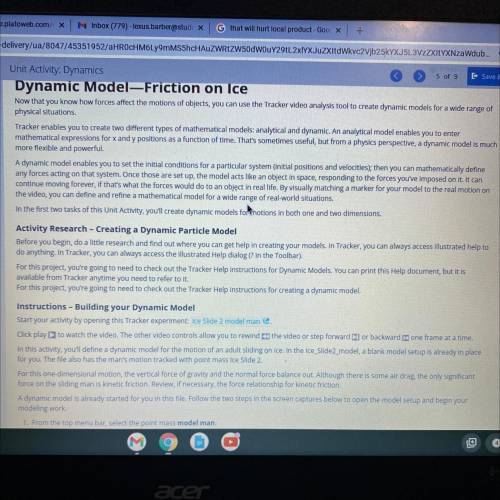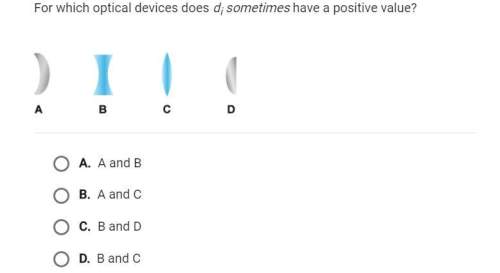
Physics, 27.10.2021 09:00 natalie2sheffield
Now that you know how forces affect the motions of objects, you can use the Tracker video analysis tool to create dynamic models
for a wide range of physical situations.
Tracker enables you to create two different types of mathematical models: analytical and dynamic. An analytical model enables you
to enter mathematical expressions for x and y positions as a function of time. That's sometimes useful, but from a physics
perspective, a dynamic model is much more flexible and powerful.
A dynamic model enables you to set the initial conditions for a particular system (Initial positions and velocities); then you can
mathematically define any forces acting on that system. Once those are set up, the model acts like an object in space, responding to
the forces you've imposed on it. It can continue moving forever, if that's what the forces would do to an object in real life. By visually
matching a marker for your model to the real motion on the video, you can define and refine a mathematical model for a wide range
of real-world situations.
In the first two tasks of this Unit Activity, you'll create dynamic models for motions in both one and two dimensions.
Activity Research - Creating a Dynamic Particle Model
Before you begin, do a little research and find out where you can get help in creating your models. In Tracker, you can always access
illustrated help to do anything. In Tracker, you can always access the illustrated Help dialog (? In the Toolbar).
For this project, you're going to need to check out the Tracker Help Instructions for Dynamic Models. You can print this Help
document, but it is available from Tracker anytime you need to refer to it.
For this project, you're going to need to check out the Tracker Help Instructions for creating a dynamic model.
Instructions - Building your Dynamic Model


Answers: 2


Another question on Physics

Physics, 21.06.2019 23:30
What are chlorofluorocarbons and what impact do they have on the atmosphere?
Answers: 1

Physics, 22.06.2019 08:00
Aheat engine running backward is called a refrigerator if its purpose is to extract heat from a cold reservoir. the same engine running backward is called a heat pump if its purpose is to exhaust warm air into the hot reservoir. heat pumps are widely used for home heating. you can think of a heat pump as a refrigerator that is cooling the already cold outdoors and, with its exhaust heat qh, warming the indoors. perhaps this seems a little silly, but consider the following. electricity can be directly used to heat a home by passing an electric current through a heating coil. this is a direct, 100% conversion of work to heat. that is, 19.0 \rm kw of electric power (generated by doing work at the rate 19.0 kj/s at the power plant) produces heat energy inside the home at a rate of 19.0 kj/s. suppose that the neighbor's home has a heat pump with a coefficient of performance of 4.00, a realistic value. note: with a refrigerator, "what you get" is heat removed. but with a heat pump, "what you get" is heat delivered. so the coefficient of performance of a heat pump is k=qh/win. an average price for electricity is about 40 mj per dollar. a furnace or heat pump will run typically 200 hours per month during the winter. what does one month's heating cost in the home with a 16.0 kw electric heater? what does one month's heating cost in the home of a neighbor who uses a heat pump to provide the same amount of heating?
Answers: 2

Physics, 22.06.2019 16:30
He latent heat of vaporization for ethyl alcohol is 854 j/g. the amount of energy, rounded to the nearest whole number, needed to change 5.20 grams of ethyl alcohol from a liquid to a gas is
Answers: 2

Physics, 23.06.2019 06:30
Takumi works in his yard for 45 minutes each saturday. he works in the morning, and he wears sunscreen and a hat each time he works in the yard. what does takumi hope to reduce through his actions? the likelihood of stochastic effects, such as dna mutations the severity of stochastic effects, such as cancer the severity of non-stochastic effects, such as cancer the likelihood of non-stochastic effects, such as radiation sickness
Answers: 3
You know the right answer?
Now that you know how forces affect the motions of objects, you can use the Tracker video analysis t...
Questions



Mathematics, 21.01.2021 14:00

Biology, 21.01.2021 14:00

Mathematics, 21.01.2021 14:00

Biology, 21.01.2021 14:00

English, 21.01.2021 14:00


Physics, 21.01.2021 14:00





Arts, 21.01.2021 14:00


Mathematics, 21.01.2021 14:00

Mathematics, 21.01.2021 14:00

Mathematics, 21.01.2021 14:00

Mathematics, 21.01.2021 14:00

Mathematics, 21.01.2021 14:00




